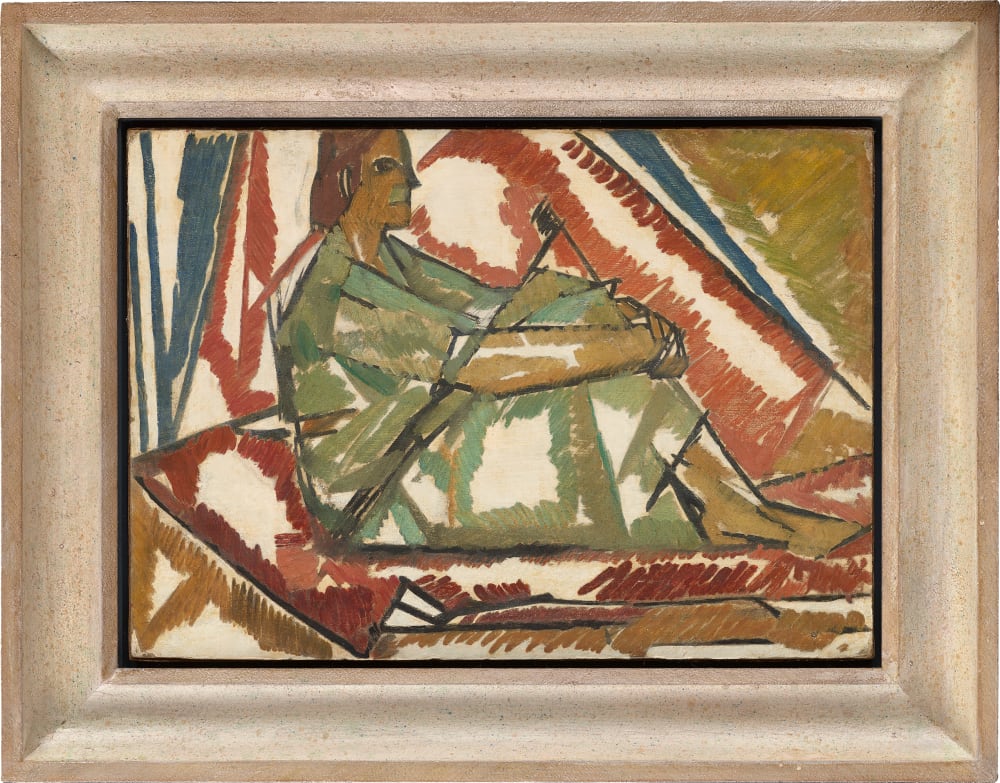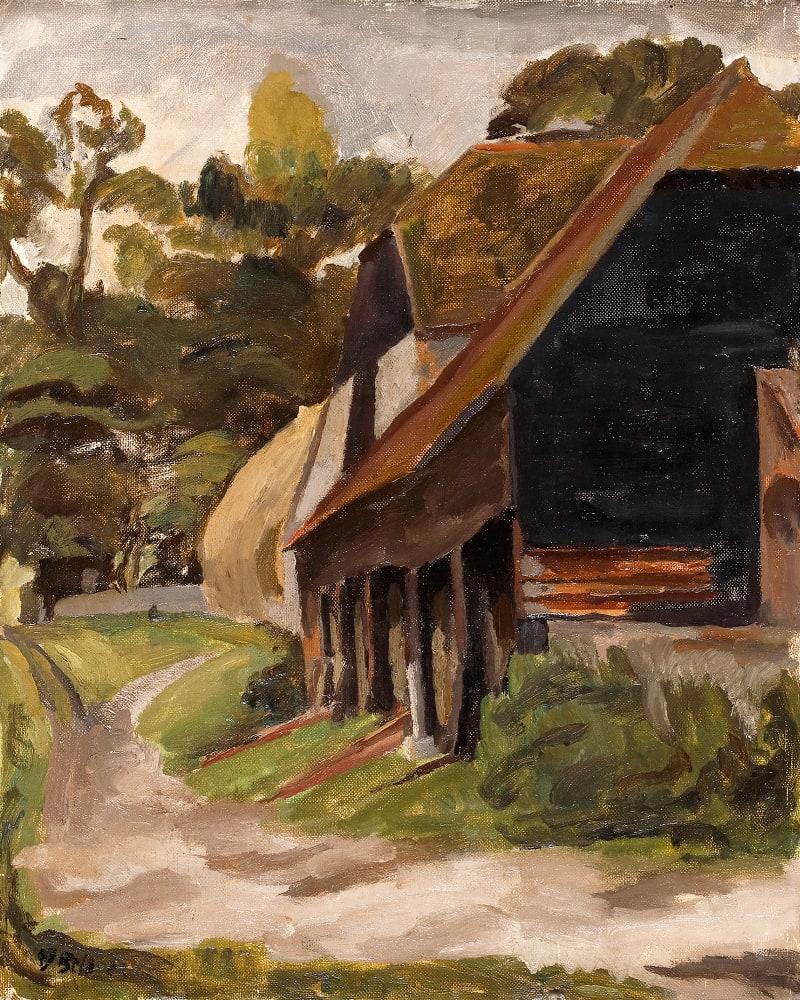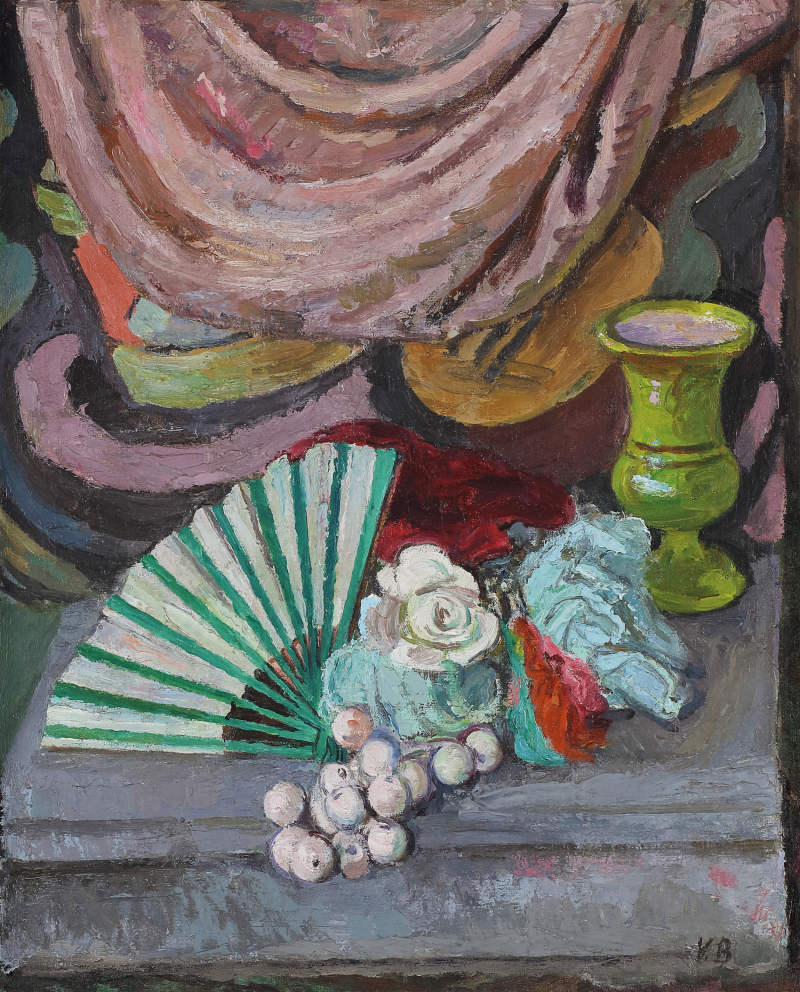To view paintings currently for sale at Philip Mould & Co, please go to <a href=https://www.philipmould.com/ target='_blank'><b><u> www.philipmould.com</b></u></a</b></u></a>.
Painted in the same year that Vanessa Bell co-founded the Omega Workshop, this remarkable and experimental painting of a seated figure beside a tent can be considered a pivotal work within the artist’s early oeuvre and was recently included in a major exhibition of Bell’s work staged at the Dulwich Picture Gallery.
This study is one of a small number of works painted by Bell in August 1913 at a summer camp at Brandon on the Norfolk-Suffolk border near Thetford. The camp lasted twelve days and there were several tents, all pitched at the edge of a field bordered by trees.[1] There was an impressive turnout and attendees included Brynhild, Margery, Noel and Daphne – daughters of Sir Sydney Olivier, Adrian Stephens, Molly MacCarthy, Ka Cox and Gerald Shove as well as several key members of the Bloomsbury Group – a...
To view paintings currently for sale at Philip Mould & Co, please go to <a href=https://www.philipmould.com/ target="_blank"><b><u> www.philipmould.com</b></u></a</b></u></a>.
Painted in the same year that Vanessa Bell co-founded the Omega Workshop, this remarkable and experimental painting of a seated figure beside a tent can be considered a pivotal work within the artist’s early oeuvre and was recently included in a major exhibition of Bell’s work staged at the Dulwich Picture Gallery.
This study is one of a small number of works painted by Bell in August 1913 at a summer camp at Brandon on the Norfolk-Suffolk border near Thetford. The camp lasted twelve days and there were several tents, all pitched at the edge of a field bordered by trees.[1] There was an impressive turnout and attendees included Brynhild, Margery, Noel and Daphne – daughters of Sir Sydney Olivier, Adrian Stephens, Molly MacCarthy, Ka Cox and Gerald Shove as well as several key members of the Bloomsbury Group – a collective of like-minded intellectuals, artists, writers and philosophers united in their belief in art and its relevance in modern life. Vanessa Bell was joined by her husband Clive along with Maynard Keynes, Duncan Grant and Rogert Fry. This brief sojourn into the wilderness was fully embraced by Bell (even though she opted to lodge in a nearby farm) and she painted at least two works - the present work and Summer Camp. In a letter to Rupert Brooke, Noel Olivier described the pleasant atmosphere of the camp and how she ‘liked to see Duncan & Vanessa at their pictures out in the field, Daphne absorbed in Dotztoyevsky [sic] & Maynard always busy with his writing’.[2]
The function of line and colour is boldly examined in this work as Bell deftly delineates the angular form of her female subject before quickly sketching in the rich, strong colours against a deliberately light background. Bell’s technique of applying the colour in short, vertical strokes is reminiscent of the work of Pablo Picasso, whose work Fry had introduced her to and whose use of colour had a profound effect on Bell’s work. Duncan Grant had also fallen under the influence of Picasso and his work Tents, painted on the same camping trip, reveals a similar application of colour in short parallel strokes. The strong geometric lines observed in our work can also be compared to Picasso’s early cubist paintings depicting the human form, although Bell makes no attempt to blend perspectives and instead maintains a shallow composition.
In July 1913, a month before this work was painted, Bell, along with Grant and Fry, opened the Omega Workshops, a cooperative for the decorative arts which emphasised bold colours and simple designs for textiles, pottery, clothing and furniture. Bell was particularly gifted in textile design and soon became known for her interior designs. Finding inspiration all around, Bell translated her compositional ideas onto all manner of interior furnishings including fire screens, over mantle murals and cushions. One of the most impressive objects created by Bell was Painted Omega Screen (Tents and Figures) which was based on the work Summer Camp painted alongside our work. Between 1913 and 1914 the workshop was at the height of innovative abilities and was quite unlike any other organisation active in Britain. With the outbreak of war in 1914, however, it became difficult to attract new artists and collaborators and by the end of the war the initial spark of innovation and invention had vanished and in 1919 the workshop closed.
This painting can be considered a defining work from this early period of Bell’s artistic activity and as such plays a vital role within the art historical narrative of the Bloomsbury Group during their most impactful years. The painting was formerly in the possession of Paul Roche, a talented poet, friend and companion of Grant, from whom it was acquired by the previous owner.
[1] Shone, R., 1999, The Art of Bloomsbury, exhibition catalogue, 4 November 1999 – 30 January 2000, p. 159
[2] Shone, R., 1999, The Art of Bloomsbury, exhibition catalogue, 4 November 1999 – 30 January 2000, p. 159









